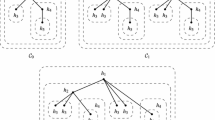Abstract
Symport and antiport are biological ways of transporting molecules through membranesin ``collaborating'' pairs; in the case of symport the two molecules pass in the same direction, in the case of antiport the two molecules pass in opposite directions. Here we first survey the results about the computing power of membrane systems (P systems) using only symport/antiport rules (hence these systems compute by communication only), then we consider a recently introduced, way of defining the result of a computation in a membrane system: looking for the trace of certain objects in their movement through membranes. Rather unexpected, in this way we get characterizations of recursively enumerable languages by means of membrane systems with symport/antiport which work with multisets of objects (note the qualitative difference between the data structure used by computations – multisets: no ordering– and the data structure of the output – strings: linear ordering). A similar remark holds true for the case of analysing P systems, which work in an automata-like manner: the sequence of certain distinguished objects taken from the environment during acomputation is the string recognized by the computation. We also survey universality results from this area, with sketched proofs. Some open problems are also formulated.
Similar content being viewed by others
References
Alberts B et al. (1998) Essential cell biology. An introduction to the molecular biology of the cell. Garland Publ. Inc., New York, London
Ardelean II (2002) The relevance of cell membranes for P systems. General aspects. Fundamenta Informaticae 49: 35–43
Csuhaj-Varju E and Vaszil G (2002) P automata. Pre-Proceedings of Workshop on Membrane Computing, Curtea de Argeş, Romania, 2002, MolCoNet Publication No. 1, pp. 177–192
Freund R and Oswald M (2002) A short note on analysing P systems. Bulletin of the EATCS 78 (October 2002): 231–236
Freund R and Păun Gh (2001) On the number of non-terminal symbols in graph-controlled, programmed and matrix grammars. In: Margenstern M and Rogozhin Y (eds) Proc. Conf. Universal Machines and Computations, Chişinău, 2001, LNCS 2055, pp. 214–225. Springer-Verlag
Frisco P and Hoogeboom HJ (2002) Simulating counter automata by P systems with symport/antiport. Pre-Proceedings of Workshop on Membrane Computing, Curtea de Argeş, Romania, 2002, MolCoNet Publication No. 1, pp. 237–248
Ionescu M. Martín-Vide C and Păun Gh (2002) P systems with symport/antiport rules: The traces of objects. Grammars 5: 65–79
Martín-Vide C, Păun A and Păun Gh (2002) On the power of P systems with symport rules. Journal of Universal Computer Science 8: 317–331
Martín-Vide C. Păaun A, Păun Gh and Rozenberg G (2002) Membrane systems with coupled transport: Universality and normal forms. Fundamenta Informaticae 49: 1–15
Martín-Vide C and Păun Gh (2001) Elements of Formal Language Theory for Membrane Computing. Technical Report 21/01 of the Research Group on Mathematical Linguistics, Rovira i Virgili University, Tarragona
Păun A (2002) Membrane systems with symport/antiport: universality results. Pre-Proceedings of Workshop on Membrane Computing, Curtea de Argeş, Romania, 2002, MolCoNet Publication No. 1, pp. 333–343
Păun A and Păun Gh (2002) The power of communication: P systems with symport/antiport. New Generation Computing 20: 295–306
Păun A, Păun Gh and Rodriguez-Paton A (2001) Further remarks on P systems with symport rules. Ann. Univ. Al.I. Cuza, Iaşi 10: 3–18
Păun A, Păun Gh and Rozenberg G (2002) Computing by communication in networks of membranes. International Journal of Fundamentals of Computer Science 13: 779–798
Păun Gh (2000) Computing with membranes. Journal of Computer and System Sciences 61: 108–143, and Turku Center for Computer Science-TUCS Report No. 208, 1998 (www.tucs.fi)
Păun Gh (2002) Computing with Membranes: An Introduction. Springer-Verlag, Berlin
Păun Gh, Rozenberg G and Salomaa A (2000) Membrane computing with external output. Fundamenta Informaticae 41: 259–266
Sosik P (2002) P systems versus register machines: Two universality proofs. Pre-Proceedings of Workshop on Membrane Computing, Curtea de Argeş, Romania, 2002, MolCoNet Publication No. 1, pp. 371–382
Author information
Authors and Affiliations
Rights and permissions
About this article
Cite this article
Ionescu, M., Martín-Vide, C., Păun, A. et al. Unexpected universality results for three classes of P systems with symport/antiport. Natural Computing 2, 337–348 (2003). https://doi.org/10.1023/B:NACO.0000006773.31625.55
Issue Date:
DOI: https://doi.org/10.1023/B:NACO.0000006773.31625.55




